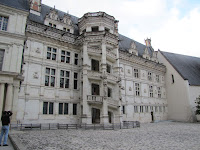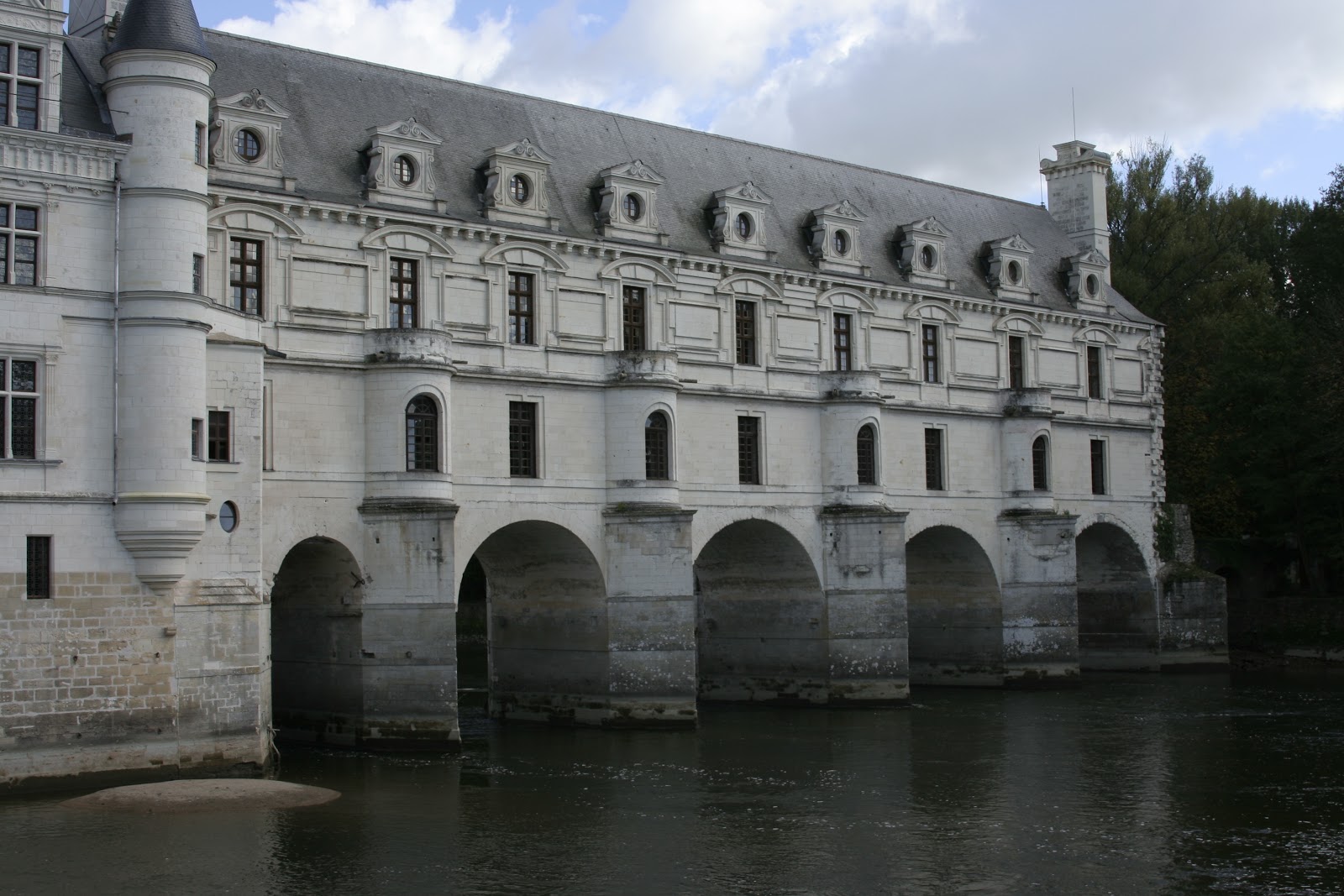Train Adventures
Like I said, the tickets were a great deal. That may have been because our train left at 6:45AM. At least it was a TGV. A couple hours and a couple hundred miles later we sleepily stepped off the train in Chambéry. We went to the hotel to drop off our bags and then planned to explore the city for a while.
At the hotel I realized my scarf was missing. Catherine made me the scarf and gave it to me last Christmas. So, it was important to me. We searched the hotel room and the train station. The station gave us a phone number to call, which was a message saying to call the terminus of the train your belongs were left on. We called the terminus station, in a town called Annecy. No one answered.
We called again a few hours later. Still no luck. They said they hadn't yet searched the train and we should call them tomorrow. At least we reached a human this time.
The next morning we started to go to Lyon. The tickets were supposed to be 35 euro total. We went to the train station to buy the tickets but they ended up being 35 euros each! Soon after we got on we called the terminus of our original train and found out they had the scarf. We got off at the first stop on the way to Lyon, without having our tickets checked. We killed an hour exploring the tiny town and the one next to it. It was really quite pretty.
Some tiny town north of Chambéry
We took the next train back to Chambéry, again without having our tickets checked, returned our expensive tickets, and bought much cheaper tickets to Annecy. It only cost us 8 euro to return the tickets, so we really paid 2 euro each way per person to see a cute little town. Not bad. An hour later we were in Annecy and I had my scarf back!
The remainder of our train travels went much more smoothly. The train ride back to Annecy was uneventful, as well as the ride back to Paris. Let me tell you now about Chambéry and Annecy.
The remainder of our train travels went much more smoothly. The train ride back to Annecy was uneventful, as well as the ride back to Paris. Let me tell you now about Chambéry and Annecy.
Chambéry
The first thing we did in Chambéry was go to the castle...we're on a bit of a castle kick right now. It turns out that the city still uses their castle. It's probably officially a historic monument, but that hasn't stopped them from putting all kinds of city offices in it. We wandered around and found there is a small museum in it. Which was "fermé." Of course if you claim you don't understand French and if the entrance is ajar, there's nothing wrong with exploring. Catherine waited for me at the bottom to tell her if it was worth going up.
Up the tower I climbed. One story, one old locked door. Two stories, another old locked door. Three stories, a modern door. I ever so slowly cracked it open to see what was inside. The sounds of a modern office drifted out as I closed it just as carefully and continued up the stairs. Four stories another old locked door. Five stories, another modern door. And I cracked it open again, only to get the same result. Deciding that I was probably pushing my luck I started to descend the spiral staircase, worrying less about being heard as I hurried out. By the time I had gone down two stories I heard footsteps behind me. I moved faster.
Pause. I'm a bit uncomfortable in spiral staircases. I worry that if I slip I will tumble all the way down. At least in a straight staircase I'll stop in a few steps. So, I was not comfortable running down.
I came out at the bottom to find Catherine confusedly looking at some French woman. I said something to her and we hustled out the door into the courtyard, as if nothing had happened.
In the courtyard there is a carillon of 37 bells that you can bang on. I hit every single one, multiple times. This was apparently worthy of a picture.
We wandered around the town for a while longer, looking in a chocolate shop, an antique book store, and a wine store. We got chocolate and wine for our dinner hosts, Olivier Jourdan and his family.
A Real French Dinner
Wavy flashback scene: August 2012. National Instruments' yearly sales conference is in the beginning of August every year. Every year the main unofficial user group meets for BBQ. I went (for the third time, woohoo!) and met some French LabVIEW users. One, Olivier Jourdan, told me to let him know if I was ever in his area. End wavy flashback scene.
Olivier works for SAPHIR, one of NI's largest partners in France. After we booked our train tickets, I remembered that SAPHIR was located somewhere in the south east of France. It turned out it's only 20 minutes from Chambéry in a small town called Pontcharra! We met Olivier at the train station in Pontcharra (of course we took the train). He took Catherine and I to the SAPHIR office and showed us around. Afterwards he brought us to his home where we met his wife and son.
Their son was just learning to produce French words, so he and I were about on the same level. We talked for a while and watched their son play. He really enjoyed dropping his toy cars in our drinks. As the night progressed we moved on to eating. Olivier and his wife Adeline cooked Raclette for us.
Raclette cheese is melted and put on top of other tasty-but-unhealthy foods like potatoes and cured meats.
We finished up and moved on to dessert: fruit salad with delicious speculoos cookies to soak up the juices. At the end of the night Olivier drove us back to our hotel and confirmed our suspicions about toll roads in France: you can't know if there will be a toll until you get to the road. We unfortunately discovered this on our castle tour in the Loire Valley. Some highways have tolls, some don't and you just don't know if you'll have to pay until you get there.
Annecy
Annecy is sometimes called the Venice of the Alps. Or the Venice of Savoy. Or the Venice of France. But, in any case, it's similar to Venice. It's built at the lower end of Lake Annecy on top of a bunch of man-made islands. The only difference is that the water is renowned for being clear. Venice's water is dirty.
The historic center of Annecy is much smaller than Venice. We were able to walk around and see most of it in just a few hours.
Annecy has a castle, of course. This castle didn't have much of it's original interior, having been converted for various uses over the years. They have modern art exhibitions inside, interspersed with very little from the castle's history.
Another wing of the castle had a great exhibit on the history of Annecy and the surrounding area, with a focus on the relationship with the lake. They had some artifacts from Annecy; old fishing rods, traps, and boats; and studies of past settlements.
Just down the road, we found a small island in the center of a canal which housed a prison for centuries.
The Palais de l'Île (Palace of the Island) was originally someone's house (a castle...). It was also a mint at some point. But for most of its existence it was a prison. It's a tiny prison -- only 5 or 10 cells, but still a place you didn't want to be. I don't imagine the accommodations were very comfortable, having seen some of the cells.
We couldn't leave Savoy without trying out its famous fondue! Catherine and I decided we hadn't had enough meat and cheese on Friday night and we ought to have more on Saturday. So, we had some authentic fondue as a warm and hearty way to end a rainy day. The cheese was much more liquidy than I expected, but that made it easier to make it last for all of the things that they gave us to douse in the cheese: a bunch of different kinds of meats, onions, and baby pickles.
The historic center of Annecy is much smaller than Venice. We were able to walk around and see most of it in just a few hours.
Annecy has a castle, of course. This castle didn't have much of it's original interior, having been converted for various uses over the years. They have modern art exhibitions inside, interspersed with very little from the castle's history.
Annecy Castle
Another wing of the castle had a great exhibit on the history of Annecy and the surrounding area, with a focus on the relationship with the lake. They had some artifacts from Annecy; old fishing rods, traps, and boats; and studies of past settlements.
Just down the road, we found a small island in the center of a canal which housed a prison for centuries.
The Palais de l'Île (Palace of the Island) was originally someone's house (a castle...). It was also a mint at some point. But for most of its existence it was a prison. It's a tiny prison -- only 5 or 10 cells, but still a place you didn't want to be. I don't imagine the accommodations were very comfortable, having seen some of the cells.
The island with the prison, on the right.
We couldn't leave Savoy without trying out its famous fondue! Catherine and I decided we hadn't had enough meat and cheese on Friday night and we ought to have more on Saturday. So, we had some authentic fondue as a warm and hearty way to end a rainy day. The cheese was much more liquidy than I expected, but that made it easier to make it last for all of the things that they gave us to douse in the cheese: a bunch of different kinds of meats, onions, and baby pickles.
Homeward Bound
We left Annecy as night fell and arrived back to our hotel in Chambéry in a downpour. Early the next morning we caught another early train to Paris. On the way back, we reflected on how nice Olivier and Adeline had been to us.
Olivier and Adeline showed us true kindness by taking us into their home and feeding us. Catherine and I really appreciated the chance to experience how people outside of Paris live. It's really very different, yet still very French. Olivier asked what we thought about stereotypes of French people being rude and we told him what we thought: it's mostly the result of hearsay and not understanding French etiquette. If you walk into a store and ask for something, that's rude. If you walk in, say hello, and then ask for something, that's fine. I think it's really that simple: just take it slow and remember to say hello.












































